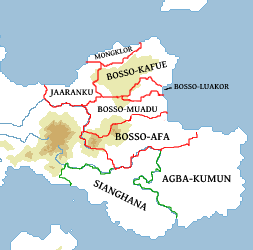Khobeh: Difference between revisions
imported>Thae |
imported>Thae |
||
| Line 119: | Line 119: | ||
==Etymology== |
==Etymology== |
||
| − | The name Khobeh comes from the historical city '' |
+ | The name Khobeh comes from the historical city ''Ŋkhɔ́bɛ̀'', meaning "central city" in [[Nyamu]] (from the words "ŋkhɔ́" (city; village) and "bɛ̀" (middle)) |
==History== |
==History== |
||
Revision as of 07:21, 30 November 2021
Kingdom of Khobeh Àgbà Khɔbɛ (Nyam) Kɔbɛ-Bà (Hlong) | |
|---|---|
|
Flag | |
Motto: X | |
| Capital | Kashinkhor |
| Official languages | Nyam Hlong |
| Recognised regional languages | Nganka Gara |
| Demonym(s) | Khobehi |
| Government | Elective constitutional monarchy |
• King (Mbolu) | Ndàkàri Jubùlà Kàṣi |
• Head of the Royal Assembly of Kashinkhor | Dada Kɔbuani |
| Legislature | Royal Assembly of Kashinkhor (Ndizu Kàṣiŋkhɔla) |
Etymology
The name Khobeh comes from the historical city Ŋkhɔ́bɛ̀, meaning "central city" in Nyamu (from the words "ŋkhɔ́" (city; village) and "bɛ̀" (middle))
History
Bosso Empire
(WIP)
Khobeh Tetrarchy

Shortly after the collapse of the Bosso Empire, four rump states arose from its former provinces, each of which were named after the dynasties of their ruling chiefs; the former province Alanku became Bosso-Kafui, the former province Ilafu became Bosso-Luakor, the former province Odo became Bosso-Muadu, the former province Eshinku became Bosso-Afa. The rulers of these four kingdoms each claimed to be the de jure successors of the Empire (hence the kingdoms' names starting with "Bosso"), and sought to reunite the former Bosso territories under their dynasty. Two other kingdoms to the north - the Hlong kingdom of Mongklor and the kingdom of Jaaranku - were also founded, but did not claim Bosso succession. Contention between the four Bosso kingdoms sparked a 5-year war, eventually ending in a stalemate.
After the war officially ended, the four kings involved appeared at a temple in the historic city of Khobeh (modern-day Kashinkhor) to sign the Kari-Jaka Treaty, unifying the four nations as the Khobeh Tetrarchy. Although they were unified, the nation was still very decentralized, as each king administered to their own region. The Tetrarchy was successful for seven years, until the same power struggles arose again, causing civil war between the regions and secession of Bosso-Afa from the Tetrarchy. Warrior Bų̄̀lą̀ Akpàlamùą̀ Kàṣi overthrew the king of the Muadu region with the help of several other clan leaders, eventually conquering the remaining Triarchy and crowning himself king of a centralized Khobeh.
